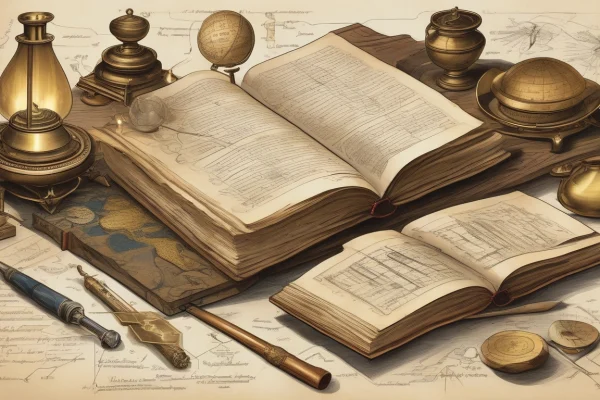The Birth of Modern Physics: Who Inspired Newton’s Laws?

- The Birth of Modern Physics: Who Inspired Newton’s Laws?
- The Scientific Revolution
- Galileo Galilei's Contributions
- Johannes Kepler's Laws
- Rene Descartes and Rationalism
- The Role of Mathematics in Physics
- Influence of Aristotle's Philosophy
- The Impact of the Enlightenment
- Collaboration and Correspondence
- Legacy of Newton's Laws
- Frequently Asked Questions
When we think of modern physics, one name often comes to mind: Isaac Newton. His laws of motion are foundational to our understanding of the physical universe. But have you ever wondered who or what inspired Newton to formulate these groundbreaking laws? This article dives deep into the historical context and key figures that influenced Newton, shaping the very foundation of scientific thought. The journey of understanding motion and forces didn’t begin with Newton; it was a collaborative effort that spanned generations.
The path to Newton’s revolutionary ideas was paved by the Scientific Revolution, a remarkable period characterized by a surge of discoveries and a fundamental shift in how we perceive the natural world. It was during this time that thinkers began to challenge traditional beliefs, leading to a new era of scientific inquiry. Newton’s laws didn’t emerge in isolation; they were built upon the shoulders of giants, each contributing pieces to the puzzle of physics.
One of the most significant influences on Newton was Galileo Galilei. His daring experiments and keen observations shattered the long-held views of motion, advocating for a method of inquiry grounded in empirical evidence. Galileo’s work laid the groundwork for Newton’s principles, encouraging a shift from philosophical speculation to a more hands-on approach to science.
Additionally, Johannes Kepler‘s laws of planetary motion were instrumental in shaping Newton’s understanding of gravity. Kepler’s meticulous observations of celestial bodies provided insights that would later inform Newton’s theories about motion, both on Earth and in space. This connection between the heavens and the Earth was crucial in developing a unified theory of motion.
Furthermore, the influence of Rene Descartes cannot be overlooked. His emphasis on rationalism and mathematical principles encouraged Newton to adopt a systematic approach to understanding the physical world. In fact, Newton’s integration of calculus into his laws of motion was revolutionary, allowing scientists to describe and predict physical phenomena with unprecedented accuracy.
In summary, the birth of modern physics was not a solitary endeavor but a rich tapestry woven from the ideas and discoveries of many brilliant minds. From Galileo’s challenges to Aristotle’s philosophies, each thread contributed to the vibrant fabric of scientific progress. Newton’s legacy, encapsulated in his laws of motion, continues to inspire and guide physicists today.
| Influential Figure | Contribution |
|---|---|
| Galileo Galilei | Challenged traditional views of motion with empirical evidence. |
| Johannes Kepler | Formulated laws of planetary motion that influenced Newton’s understanding of gravity. |
| Rene Descartes | Promoted rationalism and mathematical principles in scientific methodology. |
The Scientific Revolution
The Scientific Revolution was not just a period; it was a seismic shift in the way humanity understood the universe. Imagine a world where the stars were merely pinpricks of light in a dark sky, governed by myths and superstitions. Suddenly, thinkers began to peel back the layers of the cosmos, revealing the intricate mechanics behind celestial movements and earthly phenomena. This revolution laid the foundation for Newton’s laws and modern science, transforming our perception of reality.
During this era, a handful of brilliant minds emerged, each contributing unique insights that would shape the future of science. Here are some key figures:
- Nicolaus Copernicus – Proposed a heliocentric model of the universe, challenging the geocentric view that dominated for centuries.
- Galileo Galilei – Utilized the telescope to make groundbreaking observations, paving the way for empirical science.
- Johannes Kepler – Formulated laws of planetary motion that would later influence Newton’s gravitational theories.
These thinkers didn’t work in isolation; they were part of a larger tapestry of ideas and discoveries. The collaborative spirit of the time fostered an environment where knowledge flowed freely. For instance, the correspondence between scientists allowed them to share findings and challenge each other’s theories, leading to a more profound understanding of natural laws.
| Scientist | Contribution | Impact |
|---|---|---|
| Copernicus | Heliocentric Theory | Redefined our understanding of the solar system |
| Galileo | Experimental Method | Established the basis for modern scientific inquiry |
| Kepler | Laws of Planetary Motion | Influenced Newton’s laws of motion and gravity |
As the dust settled from this era of discovery, the world was forever changed. The Scientific Revolution ignited a flame of curiosity and skepticism that would lead to the Enlightenment and beyond. It set the stage for Newton, who would synthesize these ideas into his revolutionary laws of motion. Without this remarkable period, who knows where we would be today?

Galileo Galilei’s Contributions
Galileo Galilei, often hailed as the “father of modern observational astronomy,” played a pivotal role in shaping the scientific landscape that would later inspire Isaac Newton. His revolutionary approach to scientific inquiry was marked by meticulous observation and experimentation, challenging long-held beliefs about motion and the universe. Before Galileo, the prevailing views were largely based on Aristotelian philosophy, which posited that heavier objects fell faster than lighter ones. However, Galileo’s experiments, such as those conducted on the Leaning Tower of Pisa, showed that objects of different weights fall at the same rate in a vacuum.
One of the most significant contributions of Galileo was his use of the telescope. With this groundbreaking instrument, he made remarkable discoveries, including the moons of Jupiter and the phases of Venus. These findings not only supported the heliocentric model proposed by Copernicus but also laid the groundwork for Newton’s later theories on gravity and motion. The following table summarizes some of Galileo’s key contributions:
| Contribution | Description |
|---|---|
| Telescope Improvements | Enhanced the ability to observe celestial bodies, leading to groundbreaking discoveries. |
| Experiments on Motion | Demonstrated that objects fall at the same rate regardless of mass. |
| Support for Heliocentrism | Provided evidence that the Earth orbits the Sun, challenging traditional views. |
Galileo’s emphasis on empirical evidence and mathematical reasoning not only influenced Newton but also marked a significant shift in the scientific method. He famously stated, “All truths are easy to understand once they are discovered; the point is to discover them.” This quote encapsulates his relentless pursuit of knowledge and the importance of questioning established norms.
In summary, Galileo Galilei’s innovative spirit and groundbreaking discoveries laid the essential foundation for Newton’s laws of motion. His contributions catalyzed a shift towards modern science, emphasizing observation, experimentation, and a questioning attitude that continues to inspire scientists to this day.
Johannes Kepler’s Laws
Johannes Kepler, a name that resonates through the corridors of scientific history, was crucial in shaping our understanding of the cosmos. His laws of planetary motion not only revolutionized astronomy but also laid the groundwork for Isaac Newton’s later theories of motion and gravitation. Imagine trying to navigate a ship in uncharted waters without a compass; that was the state of astronomy before Kepler. His meticulous observations and mathematical precision provided the tools necessary for future explorers of the universe.
Kepler’s three laws fundamentally changed how we perceive the movement of celestial bodies. They are:
- First Law (Law of Ellipses): Planets move in elliptical orbits with the Sun at one focus.
- Second Law (Law of Equal Areas): A line segment joining a planet and the Sun sweeps out equal areas during equal intervals of time.
- Third Law (Law of Harmonies): The square of the period of any planet is proportional to the cube of the semi-major axis of its orbit.
These laws were not just abstract concepts; they were the keys that unlocked the door to modern physics. For instance, Kepler’s first law challenged the long-held belief that planetary orbits were circular. Instead, he introduced the idea of ellipses, which was a radical departure from the Aristotelian view of perfect circles. This shift in thinking was akin to changing the lens through which we view the universe.
Kepler’s work was heavily influenced by the data collected by Tycho Brahe, his mentor. Brahe’s precise measurements of planetary positions allowed Kepler to derive his laws, demonstrating the collaborative nature of scientific advancement. As Kepler himself stated, “I am merely a servant of the truth.” This humility reflects his dedication to the pursuit of knowledge, a trait that continues to inspire scientists today.
| Kepler’s Laws | Description |
|---|---|
| First Law | Planets orbit the Sun in ellipses. |
| Second Law | Equal areas in equal times. |
| Third Law | Relationship between period and distance from the Sun. |
In conclusion, Kepler’s laws not only influenced Newton but also forever changed our understanding of the universe. They serve as a reminder that the journey of scientific discovery is often a collaborative effort, built on the foundations laid by those who came before us.

Rene Descartes and Rationalism
When we think about the foundations of modern science, Rene Descartes often comes to mind as a pivotal figure. His emphasis on rationalism—a belief that reason is the primary source of knowledge—revolutionized the way we approach scientific inquiry. Imagine a world where thoughts were merely based on tradition and authority; Descartes shattered that illusion, advocating instead for a methodical approach grounded in logic and mathematics.
Descartes famously declared, “Cogito, ergo sum” (I think, therefore I am), which highlights his belief in the power of the individual mind. This philosophy not only influenced his own work but also set the stage for Isaac Newton and his groundbreaking laws of motion. By promoting a systematic method of thinking, Descartes encouraged scientists to question established norms and seek answers through observation and deduction.
One of the most impactful aspects of Descartes’ philosophy was his integration of geometry and algebra. He introduced a coordinate system that allowed for the mathematical representation of physical phenomena, which was crucial for Newton’s later work. To illustrate this point, consider the following table that outlines some key contributions of Descartes:
| Contribution | Description |
|---|---|
| Cartesian Coordinates | Introduced a system to represent geometric shapes algebraically. |
| Analytical Geometry | Combined algebra and geometry, laying the groundwork for calculus. |
| Method of Doubt | A systematic way to question beliefs and seek truth through reason. |
Through his innovative thinking, Descartes inspired not only Newton but also countless other scientists who followed. His approach encouraged a community of thinkers to embrace skepticism and inquiry. In essence, Descartes’ rationalism was like a spark that ignited the flame of the Scientific Revolution, leading to an explosion of knowledge that transformed our understanding of the natural world.
In summary, the influence of Rene Descartes on modern science is undeniable. His insistence on reason and mathematical principles created a new paradigm for scientific exploration. As we delve deeper into the history of physics, we can see how his ideas paved the way for monumental advancements, including Newton’s laws of motion.
The Role of Mathematics in Physics
Mathematics is often described as the language of physics, and this statement couldn’t be more accurate. Just like a musician uses notes to create a symphony, physicists use mathematical equations to describe the universe’s intricate dance. Isaac Newton, in particular, made groundbreaking strides by integrating calculus into his laws of motion, which allowed him to articulate concepts of force and motion with unprecedented precision. Imagine trying to navigate a complex maze without a map—this is akin to understanding physical phenomena without mathematics.
To appreciate the profound impact of mathematics on physics, consider the following key aspects:
- Descriptive Power: Mathematics provides the tools to describe physical laws quantitatively. For example, Newton’s second law, \( F ma \), succinctly relates force, mass, and acceleration.
- Predictive Capability: Mathematical models allow scientists to predict outcomes of physical systems, enabling advancements in technology and engineering.
- Framework for Theories: Mathematics serves as a foundation for developing theories, such as Einstein’s theory of relativity, which relies heavily on differential geometry.
Moreover, the collaboration between mathematics and physics has fostered innovations that have shaped our understanding of the natural world. For instance, the development of calculus by Newton and Leibniz in the 17th century was not just a mathematical triumph but also a pivotal moment for physics. It enabled scientists to analyze changes and motion in a systematic way, laying the groundwork for modern physics.
In summary, the role of mathematics in physics is not merely supportive; it is essential. Without mathematics, the elegant laws that govern the universe would remain abstract concepts, inaccessible to our understanding. As we delve deeper into the mysteries of the cosmos, the partnership between mathematics and physics will continue to illuminate the path forward, revealing the interconnectedness of all things.
| Mathematical Concepts | Applications in Physics |
|---|---|
| Calculus | Describing motion and change |
| Linear Algebra | Quantum mechanics and systems |
| Differential Equations | Modeling dynamic systems |
Influence of Aristotle’s Philosophy
Aristotle, the ancient Greek philosopher, was a towering figure whose ideas shaped the foundations of Western thought. His views on physics and motion dominated scientific discourse for centuries, creating a framework that influenced not just his contemporaries but also future thinkers like Isaac Newton. While Aristotle’s philosophy provided a solid base for understanding the natural world, it was also a double-edged sword, as it limited the scope of inquiry and experimentation.
One of Aristotle’s key contributions was the concept of natural motion and violent motion. He believed that objects moved towards their natural place—earthy materials towards the ground and fire upwards. This idea was revolutionary at the time, but it also created a static view of the universe that Newton would later challenge. Aristotle’s emphasis on qualitative descriptions rather than quantitative analysis meant that his theories lacked the precision that Newton sought.
To illustrate the contrast between Aristotle’s philosophy and Newton’s laws, consider the following table:
| Aspect | Aristotle’s View | Newton’s View |
|---|---|---|
| Nature of Motion | Natural vs. Violent | Inertia and Force |
| Methodology | Qualitative | Quantitative |
| Understanding of Gravity | Objects seek their natural place | Universal gravitation |
Aristotle’s influence can also be seen in the way he encouraged critical thinking and observation. Although his conclusions were often flawed, his approach laid the groundwork for future scientists. As the Enlightenment progressed, thinkers began to question Aristotle’s assertions, paving the way for a more empirical and mathematical approach to science.
In essence, while Aristotle’s philosophy provided a crucial starting point for scientific inquiry, it ultimately served as a stepping stone for Newton and others to develop a more dynamic understanding of the universe. Newton’s laws of motion not only contradicted Aristotle’s views but also marked a significant leap towards modern physics, showcasing the importance of questioning established beliefs.
The Impact of the Enlightenment
The Enlightenment was a remarkable period that ignited a flame of intellectual curiosity and critical thinking across Europe. This era, often referred to as the Age of Reason, paved the way for a profound transformation in how people perceived the world around them. Think about it: a time when the shackles of tradition were loosened, allowing fresh ideas to flourish! It was during this vibrant period that thinkers like Isaac Newton began to question established beliefs and seek truths through observation and reason.
One of the most significant impacts of the Enlightenment was the emergence of a new scientific mindset. Scholars began to prioritize empirical evidence over dogma, leading to groundbreaking discoveries that reshaped our understanding of the universe. The influence of Enlightenment thinkers can be summarized in the following key aspects:
- Critical Thinking: Challenging accepted norms and questioning authority became essential.
- Empiricism: Emphasizing observation and experimentation as the basis for knowledge.
- Mathematical Rigor: Promoting the use of mathematics to describe natural phenomena.
- Interdisciplinary Collaboration: Encouraging communication among various fields of study.
Newton’s work was a direct product of this revolutionary environment. He was not just a passive recipient of knowledge; he actively engaged with the ideas of his contemporaries. The interplay of thoughts among scientists and philosophers was akin to a grand symphony, where each voice contributed to a harmonious understanding of the world. As Newton himself once stated,
“If I have seen further, it is by standing on the shoulders of giants.”
This quote exemplifies how the Enlightenment fostered collaboration and the exchange of ideas, allowing figures like Newton to build upon the foundations laid by others.
In conclusion, the Enlightenment was instrumental in shaping the trajectory of modern science. It encouraged a spirit of inquiry and skepticism that not only influenced Newton but also laid the groundwork for future generations of thinkers. The legacy of this era continues to resonate today, reminding us of the power of reason and the importance of questioning the status quo.

Collaboration and Correspondence
In the realm of scientific discovery, collaboration and correspondence can often ignite the spark of innovation. For Isaac Newton, the exchange of ideas with his contemporaries was not just beneficial; it was essential. The scientific community during Newton’s time was vibrant and filled with brilliant minds, each contributing to the tapestry of knowledge that would eventually lead to the formulation of his groundbreaking laws of motion.
One notable figure was Robert Hooke, a fellow scientist who engaged in a series of correspondences with Newton. Hooke’s work on elasticity and his law of springs provided vital insights that helped Newton refine his theories. Their discussions were often intense and sometimes contentious, reflecting the passionate nature of scientific inquiry. Despite their disagreements, the interplay of their ideas pushed Newton to clarify his own thoughts and deepen his understanding of motion.
Moreover, the rivalry with Gottfried Wilhelm Leibniz over the invention of calculus also highlights the importance of correspondence in shaping Newton’s work. While both men independently developed calculus, their exchanges fueled a competitive spirit that ultimately advanced mathematical concepts. This rivalry, rather than hindering progress, showcased how collaboration—even in competition—can lead to monumental breakthroughs in science.
| Scientist | Contribution | Impact on Newton |
|---|---|---|
| Robert Hooke | Law of elasticity | Refined theories of motion |
| Gottfried Wilhelm Leibniz | Calculus | Advanced mathematical concepts |
Newton’s correspondence with other scientists was not merely a matter of sharing ideas; it was a dynamic exchange that shaped the very framework of modern physics. Through letters and discussions, Newton was able to challenge existing paradigms and embrace new concepts. This collaborative spirit is a testament to the notion that science is not a solitary endeavor but a collective journey toward understanding the universe.
In conclusion, the collaboration and correspondence among scientists of Newton’s era played a pivotal role in the development of his revolutionary laws. Their shared dedication to inquiry and exploration laid the groundwork for future discoveries, proving that great minds truly do think alike, even when they disagree.
Legacy of Newton’s Laws
The extends far beyond the realm of physics; it has permeated every aspect of scientific inquiry and technological advancement. Isaac Newton didn’t just formulate laws; he laid the very foundation upon which modern science stands. His three laws of motion, introduced in the Philosophiæ Naturalis Principia Mathematica, have become essential principles that govern everything from the simplest actions to the most complex interactions in the universe.
To appreciate Newton’s impact, consider how his laws have influenced various fields. For instance, in engineering, Newton’s laws are crucial for designing everything from bridges to spacecraft. In medicine, they help us understand the mechanics of human motion and the forces acting on the body. The relevance of his work is truly universal.
| Field | Application of Newton’s Laws |
|---|---|
| Engineering | Bridge construction and aerodynamics |
| Aerospace | Rocket propulsion and satellite dynamics |
| Medicine | Biomechanics and rehabilitation |
| Sports | Analysis of athletic performance |
Moreover, Newton’s influence is evident in the way we approach scientific problems today. His emphasis on empirical evidence and mathematical reasoning has inspired countless scientists and thinkers. As the philosopher Albert Einstein once remarked, “Newton’s laws are the foundation upon which the edifice of modern physics is built.” This sentiment encapsulates the enduring significance of Newton’s work.
In addition to his scientific contributions, Newton’s legacy also includes his role in fostering a culture of collaboration and communication among scientists. His correspondence with contemporaries like Robert Hooke and Gottfried Wilhelm Leibniz exemplifies how the exchange of ideas can lead to groundbreaking advancements. This collaborative spirit continues to drive scientific progress today.
In conclusion, Newton’s laws not only revolutionized physics but also laid the groundwork for future discoveries across various disciplines. The ripple effect of his work is felt in every corner of science, making him a towering figure whose legacy will endure for generations to come.
Frequently Asked Questions
- What inspired Isaac Newton to formulate his laws of motion?
Newton was influenced by several key figures of the Scientific Revolution, notably Galileo Galilei and Johannes Kepler. Their groundbreaking work in motion and planetary laws laid the foundation for Newton’s own theories.
- How did Galileo Galilei contribute to Newton’s work?
Galileo’s experiments challenged traditional views of motion, emphasizing empirical evidence. His ideas about inertia and the acceleration of falling objects directly influenced Newton’s formulation of his laws.
- What role did mathematics play in Newton’s laws?
Mathematics was essential for Newton; he integrated calculus into his laws of motion, providing a precise language to describe and predict physical phenomena. This mathematical approach revolutionized the field of physics.
- Did Aristotle’s philosophy influence Newton?
Yes, Aristotle’s ideas dominated early science, but Newton’s work marked a significant departure from Aristotelian physics. He introduced a new understanding of motion and forces that contradicted Aristotle’s views.
- What was the impact of the Enlightenment on Newton’s work?
The Enlightenment fostered a spirit of inquiry and skepticism, encouraging scientists like Newton to challenge established beliefs. This intellectual environment was crucial for the development of modern scientific thought.
- How did collaboration shape Newton’s ideas?
Newton’s correspondence with contemporaries like Robert Hooke and Gottfried Wilhelm Leibniz played a vital role in shaping his thoughts. This exchange of ideas illustrates the collaborative nature of scientific advancement during that era.
- What is the legacy of Newton’s laws of motion?
Newton’s laws have had a profound and lasting impact on physics and various scientific fields. They paved the way for future discoveries and established Newton as a pivotal figure in the history of science.





